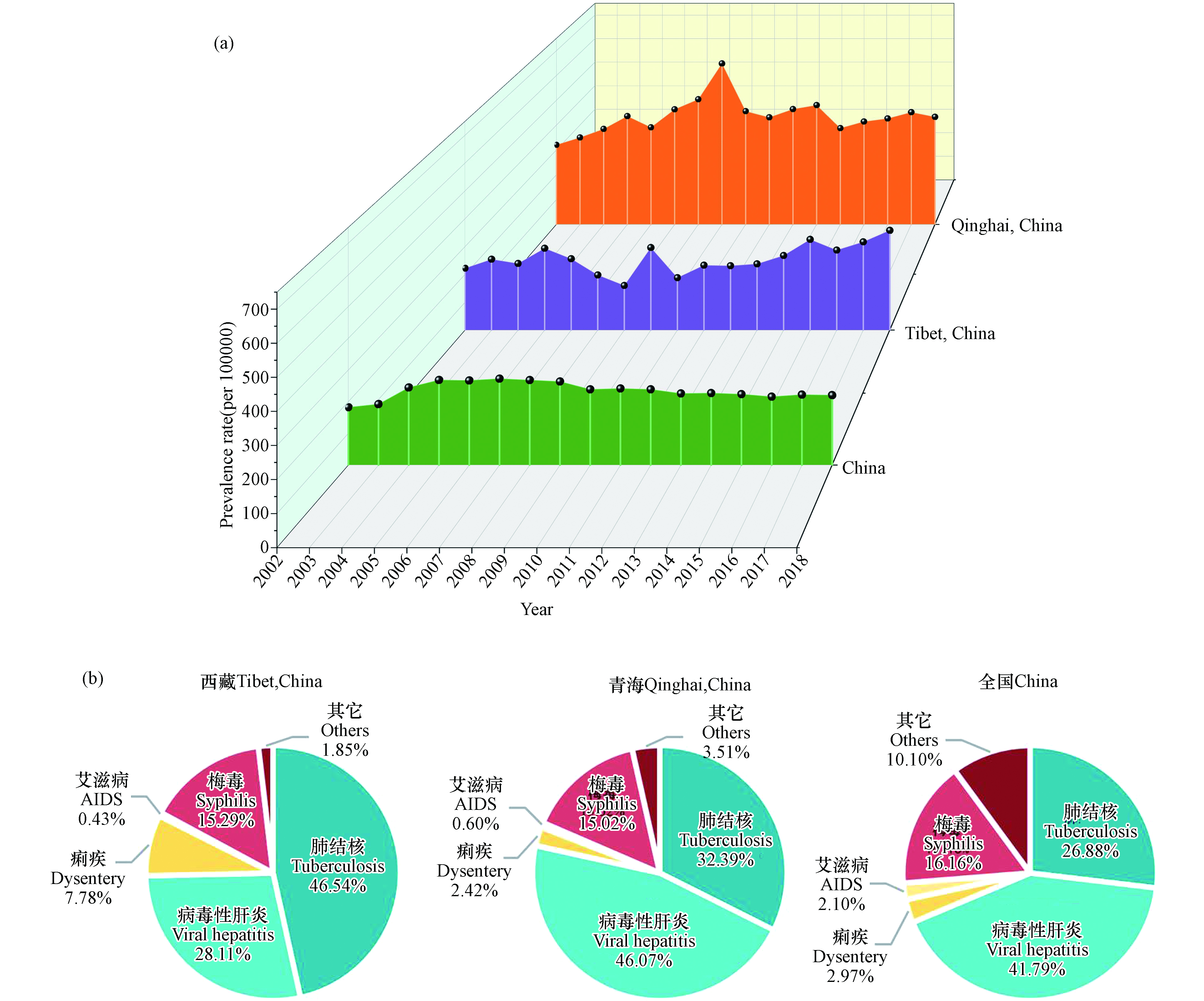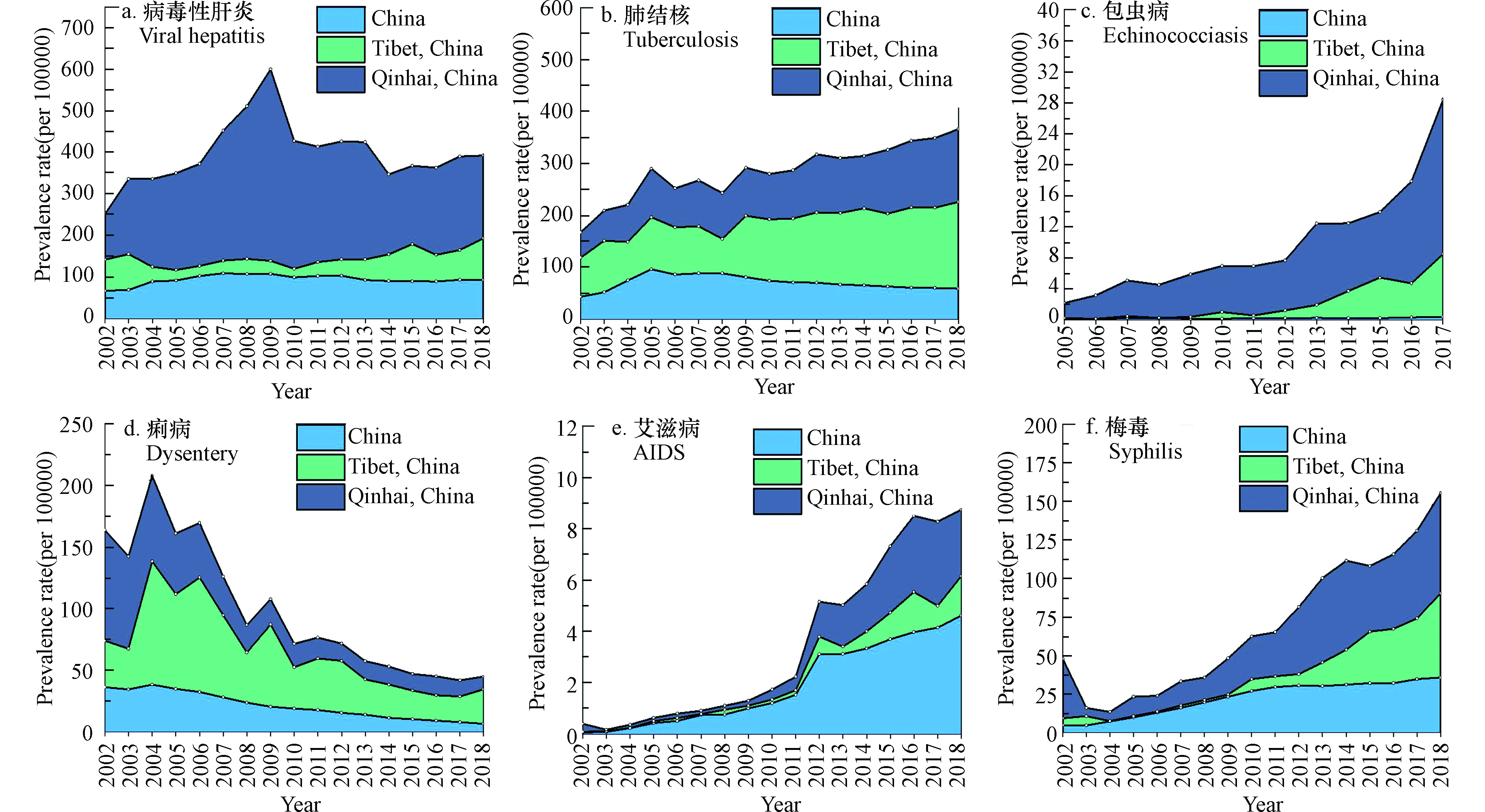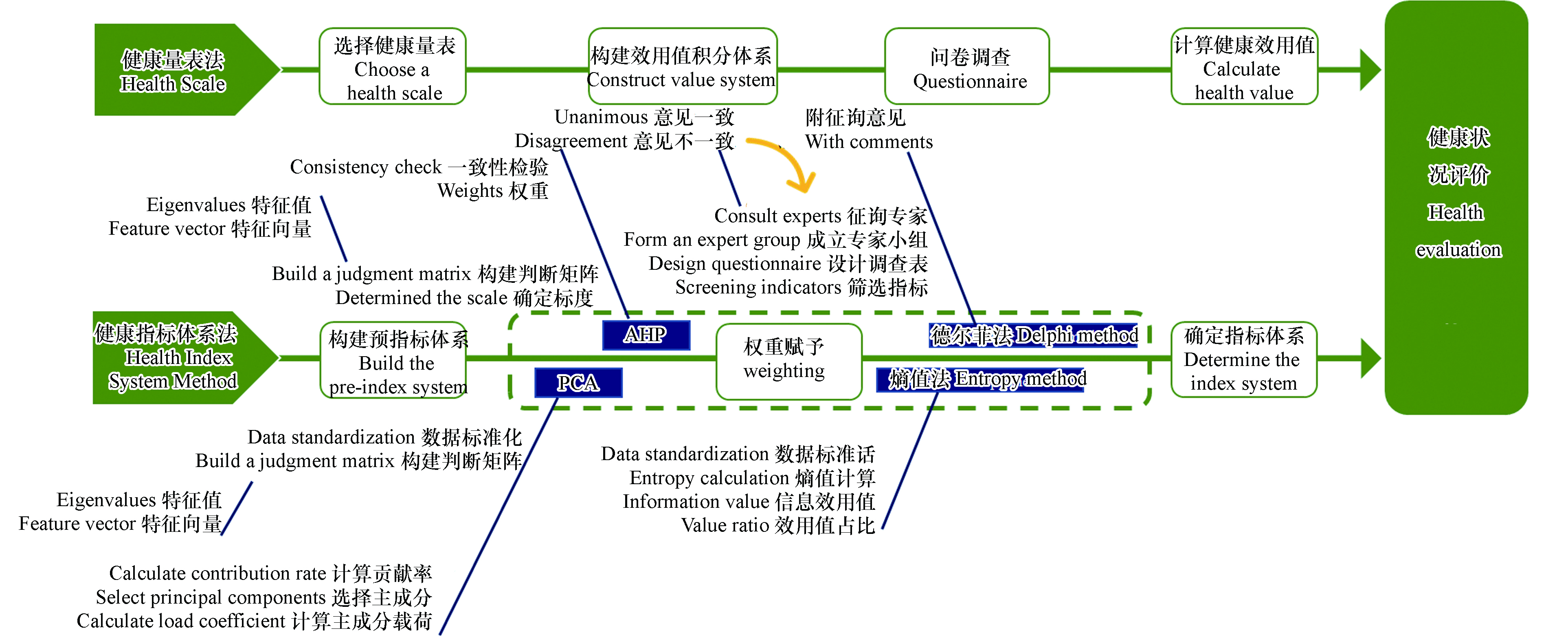-
随着经济和社会的发展,国家对人民的身心健康问题愈加重视。中共中央、国务院于2016年10月25日印发并实施《“健康中国2030”规划纲要》,指出推进健康中国建设,是全面建成小康社会、基本实现社会主义现代化的重要基础,是全面提升中华民族健康素质、实现人民健康与经济社会协调发展的国家战略。同时对于数据和规定差异较大的地区,应加强对人民身体素质的数据监测,积极探索人群差异。为了全面提高国民健康水平,国务院于2019年7月提出健康中国行动(2019—2030),精准提出了124项指标,计划在2030年,我国整体健康水平提高到一定的层次。因此,对全国各个区域,尤其是生态环境较为恶劣,经济发展水平较为落后区域人群健康水平的调查和研究,对于推进健康中国行动至关重要。
青藏高原位于我国西南地区,总面积约为250万平方公里,约占我国国土面积四分之一,平均海拔在4000 m以上,是中国最大、世界海拔最高的高原,被称为“世界屋脊”。行政区划主体为西藏自治区、青海省全境,边缘包括新疆、甘肃、云南、四川等地的部分区域。作为青藏高原核心区域的西藏自治区在和平解放初期全区人口只有95.7万人,人口平均期望寿命只有36岁[1],全区处于人口数量低、死亡率高、寿命短的状态。经过60多年的发展至2018年底,西藏地区健康水平得到了大幅度的提升,全区人口增长到343.8万[2-3],人口平均期望寿命值上升至70.6岁[4-6],但是和全国平均水平相比,仍然有较大的差距。疾病是反映地区健康状况的主要指标,青藏高原独特的地理环境、饮食结构及气候条件导致该地区传染病、地方病高发,从而限制了该地区健康水平的提升。目前青藏高原区域疾病的研究主要集中于大骨节病、包虫病等某一种疾病的流行特征、影响因素及对健康状态的影响,而对主要疾病类型全局的流行特征、各疾病之间流行特征的差异性及健康状况的综合评价缺乏系统深入的研究。因此,研究青藏高原区域主要疾病的时间变化趋势和空间分布差异,分析流行特征,探究主要疾病的影响因素,并对健康状况进行评价是推进健康中国行动的重中之重。
本研究通过分析青藏高原地区各疾病的现状,解析主要疾病的种类,探究其流行特征及相关影响因素,明晰疾病预防及控制的方向;分析目前主要健康状况评价方法的优缺点,结合青藏高原地区特殊人文地理环境,提出适用于青藏高原地区的健康评价方法,为更加全面了解不同区域整体健康水平差异和主导致病因素提供研究方向,为实现《“健康中国2030”规划纲要》提供依据和参考。
-
基于青藏高原特殊的地理环境、生活习惯及气候条件分析,目前影响该地区健康水平的主要疾病为传染病和地方病,其中传染病又可分为高原常见传染病和常规传染病。高原常见传染病是在高原地区比较常见,或者患病率远远高于其他地区的传染病;常规传染病指青藏高原和我国其他区域均较为常见的传染病,该类传染病的患病率低于高原常见传染病,但对群众健康水平和社会发展的影响不容小觑;地方病是指在特殊环境下产生的区域性疾病。由于青藏高原区域行政划分复杂,数据较难获得,因此本文以青藏高原的主体,即西藏自治区和青海省为研究对象,从高原常见传染病、常规传染病以及高原地方病这3个主要疾病种类来进行分析,其中甲乙类传染病患病率数据来自中国卫生统计年鉴、中国卫生和计划生育统计年鉴以及中国卫生健康统计年鉴,包虫病数据来自公共卫生科学数据中心(http://www.phsciencedata.cn)。
图1是2002—2018年西藏、青海、全国地区甲乙类传染病时间变化趋势及2018年主要甲乙类传染病占比图。从图1(a)中可以看出,自2007年起我国整体甲乙类传染病的患病率逐年缓慢下降,青海地区从2009年后总体呈下降趋势,但始终高于西藏和全国平均水平。西藏地区2010年以前传染病患病率波动较大,自2010年以后开始以较低的速率逐年上升,2013年超过全国平均水平,并于2018年年底达到全国平均水平的1.6倍[4-6]。目前青海和西藏地区传染病水平均高于全国水平,为甄别出各区域主要传染病类型,分析了2018年西藏、青海、全国地区主要甲乙类传染病占比,如图1(b)所示。从图1可以看出,不同区域的主要传染病类型有所差异,其中西藏地区目前的主要传染病为肺结核(46.5%)、病毒性肝炎(28.1%),青海地区的主要传染病为病毒性肝炎(46.1%)、肺结核(32.4%),全国范围的主要传染病为病毒性肝炎(41.8%)、肺结核(26.9%)。
青藏高原是我国最大的鼠疫疫源地,目前青藏高原地区患病率为零,据研究报道该甲类传染病在动物间仍有传播。除上述3种甲乙类传染病外,包虫病也是高原常见传染病之一,该病在我国西部地区患病率较高,是导致西部地区群众贫困的主要原因之一。青藏高原常规传染病主要有痢疾、艾滋病、梅毒和狂犬病等。除了上述传染病外,特殊的地理环境、饮食结构也导致了地方病高发,目前主要的地方病有急性高原病、慢性高原病、大骨节病、氟中毒及碘缺乏等。本文将重点关注高原常见传染病、常规传染病及高原地方病,结合时间变化趋势探究上述疾病的流行特征,从环境和人文角度出发,综合分析致病因素,并提出相应的解决政策。
-
病毒性肝炎是目前青海省患病率最高的甲乙类传染病。2002—2018年期间西藏、青海和全国病毒性肝炎患病率随时间变化的趋势如图2(a)所示。从图2可以看出,青海的病毒性肝炎患病率远远高于西藏和全国水平,在2009年达到峰值(461.8/10万),分别是全国和西藏患病率的4.3倍和14.8倍,自2009年起,青海病毒性肝炎患病率大幅度下降,2018年底降至199.6/10万,但仍是全国水平的2倍。全国病毒性肝炎近年来整体也呈现缓慢下降趋势,而西藏地区自2010年开始,病毒性肝炎呈缓慢上升趋势,2018年已经超过全国平均水平[4-6]。有研究表明,肝炎主要由细菌、病毒、药物以及酒精等不同病因引起,传播途径主要为饮食和血液,此外患病率与种族、海拔和年龄呈现一定的关系。有学者对阿里地区人民医院首次就诊的藏族人群进行统计学分析,结果显示阿里地区主要患病人群为农牧民,患病年龄段为30—39、50—59岁。多因素非条件logistic分析结果显示,年龄大于50岁、母婴传播、乙肝认知匮乏、饮酒、生活不规律、未规律治疗是肝硬化进一步恶化为肝硬化失代偿期及原发性肝癌的相关因素[7]。另外,慢性肝炎的肝外相关病主要为顽固性皮炎、消化性溃疡和甲亢,预防和控制上述3种疾病,可以降低慢性肝炎的发病率[8]。因此,政府可以通过科普病毒性肝炎致病原因,引导群众改善生存环境和习惯,并通过监测把控肝外相关疾病进行预警,进而从源头降低病毒性肝炎的发病率。
肺结核是目前西藏自治区患病率最高的甲乙类传染病。2002—2018年期间西藏、青海和全国肺结核患病率时间变化趋势如图2(b)所示,自2005年开始,全国肺结核患病率开始逐年下降,由峰值96.3/10万降至59.3/10万(2018年),而青海和西藏地区与此相反,青海地区从2002年开始,总体呈上升趋势,由48.7/10万(2002年)上升至140.3/10万(2018年);西藏地区由2008年开始呈逐年上升趋势,并于2009年超过全国和青海地区,截止至2018年年底,西藏地区肺结核患病率已经达到166.7/10万,为全国平均水平的2.8倍[4-6]。研究表明,肺结核主要通过飞沫传播,与生存环境联系紧密,生活在拥挤、潮湿环境或长期暴露于大量粉尘、化学气雾的人群患病率会显著增加。流行特征显示患病率易受到海拔、种族、年龄、疫苗接种率等因素的影响。高原地区肺结核发病率为平原地区的5—10倍,且治愈率较低,仅为58.3%,而平原地区治愈率为94.8%,其中海拔3000—4000 m地区结核病最为严重,可能是因为该地区人员相对集中且人员疫苗接种率低;高原地区结核病患者以藏族人居多,可能与藏区牧民生活习惯及肺结核防治教育不足有关[9];肺结核患病年龄段高峰为60—65岁,且男性患病率高于女性[10]。饶华祥等[11]利用空间截面回归模型分析了青海省2013年肺结核患病率与社会因素的相关性,结果显示农村居民人均收入是影响肺结核患病率的主要因素。因此,在提高疫苗接种率,改善生存环境切断其传播途径的同时,还应充分考虑社会经济因素,多维度全方位的并行控制措施是降低青藏高原地区肺结核患病率的有效手段。
青藏高原是我国最大的鼠疫疫源地,鼠疫的宿主主要是喜马拉雅旱獭等啮齿类动物,青藏高原面积辽阔,拥有大量的优良牧草,当地的地理结构和环境很适合旱獭生存和繁殖,部分喜马拉雅旱獭携带有鼠疫杆菌,一般通过皮肤和黏膜感染人体,青藏高原地区群众主要是通过捕猎与旱獭尸体直接接触感染鼠疫[12]。与平原地区不同,青藏高原地区人类感染鼠疫后具有发病急、病情重、病死率高等特点[13]。2010年西藏朗县6名牧民感染鼠疫,首发病例为腺鼠疫,继发均为肺鼠疫,病死率为16.7%。2011—2018年西藏地区和青海省无人间鼠疫报告[14],而动物间鼠疫仍有发生,虽然呈现下降趋势,但局部依然活跃[15]。另外,藏系绵羊、黑唇鼠兔、藏狐等物种也能通过斧型盖蚤、谢氏山蚤等媒介自然感染鼠疫,参与鼠疫流行[16]。目前,预防鼠疫的主要方法是宣讲鼠疫防治知识,尤其是外来人员,做到不私自捕猎疫源动物、不剥食疫源动物、不私自携带疫源动物及其产品[14]。
包虫病是一种由包虫(棘球绦虫的幼虫)所致的人兽共患寄生虫病,能对人体健康和生命安全造成严重危害,其在西藏和青海地区均为高发传染病。2005—2017年期间西藏、青海和全国包虫病患病率时间变化趋势如图2(c)所示,全国包虫病平均患病率远远低于西藏、青海地区,但整体呈现上升趋势,由0.056/10万(2005年)上升至0.394/10万(2017年);西藏地区2012年之前整体处于较低的水平,2012年开始呈现上升趋势,由1.01/10万(2012年)上升至8.1/10万(2017年);青海地区整体呈快速上升趋势,其中在2013、2016、2017年出现爆发式增长,2017年底患病率为全国平均水平的50倍,西藏为全国平均水平的21倍。2016年国家卫生计生委对西藏地区的调研显示,该病在西藏地区呈现空间聚集性,并随着海拔升高患病率逐渐增加[17]。青藏高原地区能为包虫提供适宜的生存环境,而当地居民人畜混居的生活方式,以及食用生肉或风干肉、饮用未经处理的水等饮食习惯也进一步导致该病难以根治,吴文婷[18]对青藏高原地区包虫病高流行区人群患病进行多因素条件logistics回归性分析,发现患病因素主要为养犬、对犬粪不处理、周围有流浪犬、喂犬病畜内脏及饮水来源。另有研究表明,地表温度过高会降低包虫存活率,导致患病率会随季节波动。包虫病是我国西部农牧区群众因病致贫、因病返贫的主要原因之一,尤其是青藏高原部分地区包虫病年均可产生0.81个失能调整生命年,人均年经济损失达127元[19]。因此,通过普及该病预防知识,加强犬类管理并进行定期驱虫,强化群众卫生行为规范,可以有效降低包虫病患病率,进而提高当地健康水平。
-
痢疾是在全国范围内普遍存在的一种乙类传染病,2002—2018年期间西藏、青海和全国痢疾患病率随时间变化趋势如图2(d)所示,期间西藏、青海地区的患病率整体高于全国平均水平。其中青海痢疾患病率在2002—2018年期间整体呈下降趋势,由89.7/10万降至10.5/10万,2008年以前降幅较快,年平均下降率为12.5%,2008年以后降幅减缓,年平均下降率为5%;2002—2018年期间,全国由36.2/10万降至6.6/10万,降速平缓,无较大波动,年平均下降率为5%;西藏地区总体呈波动式下降趋势,其中2002至2010年期间痢疾患病率波动较大,2004年患病率出现爆发式增长,达到峰值99.94/10万,2010年以后变化幅度减小。目前西藏地区痢疾患病率为全国水平的4.2倍,青海地区为全国的1.6倍[4-6]。有学者分析了西藏自治区2005—2015年痢疾流行特征,统计学结果显示痢疾发病具有明显季节性和年龄特征,其中7、8月份最高,0—9岁患病率最高,患病人群以学生、农民及散居儿童为主,患病原因与上述人群的居住环境和饮食条件有较大关系[20-21]。另外,王晓风等[22]通过地理探测器的风险区探测结果显示,夏季平均气温低、降水量少、相对湿度低、人口密度低、地区生产总值低的地区,痢疾平均患病率高,平均海拔高、海拔标准差大、平均坡度大的地区,痢疾平均患病率高,认为气象因子、地形因子决定痢疾流行的人群基础,经济水平、卫生条件直接影响痢疾在人群间的传播,最终影响痢疾患病率高低。针对痢疾的防控策略,可以通过重点对患病率较高的人群进行知识普及,关注该人群的居住和饮食条件并利用经济手段干预来有效降低痢疾患病率。
艾滋病是目前我国死亡率最高的甲乙类传染病,2018年死亡人数高达18780。2002—2018年期间西藏、青海和全国艾滋病患病率随时间的变化趋势如图2(e)所示。从图2可以看出,近年来全国艾滋病患病率远远高于青海地区,青海地区高于西藏地区。近17年来全国艾滋病患病率总体呈上升趋势,在2003—2011年期间艾滋病患病率稳步增长,2004年以后,全国艾滋病患病率始终高于西藏和青海地区,2012年呈爆发式增长;青海和西藏地区艾滋病患病率的整体增长速率与全国基本持平,其中在2003—2009年期间两地区患病率相差不大,但2009年以后,青海地区患病率开始显著高于西藏地区[4-6]. 2004—2013年西藏艾滋病患病人群分析显示,传播路径主要为性传播(81.12%)和毒品注射(9.24%),感染职业主要为家政、家务及待业(28.11%)、服务行业(14.46%)、农民工(12.45%)及干部(12.45%)[23]。
梅毒是除病毒性肝炎、肺结核外,患病率最高的甲乙类传染病,传播途径与艾滋病基本一致,性行为是两种疾病的主要传播途径。2002—2018年期间西藏、青海和全国梅毒患病率随时间变化的趋势如图2(f)所示,2004年开始,青藏高原地区与全国的梅毒患病率总体都呈现上升趋势,2010年开始全国上升趋势减缓,而青海和西藏地区先后于2011、2015超过全国水平,2018年底分别达到65.1/10万和54.8/10万,分别为全国水平的1.8倍和1.5倍。梅毒患者的死亡率较低,且治愈率远高于艾滋病。2018年西藏地区没有死亡病例,青海梅毒死亡率为0.02/10万,远低于艾滋病(1.4/10万)。关于艾滋病和梅毒的预防,应该重点针对疾病高发人群加大科普教育,普及性知识并加强毒品监管打击力度以降低艾滋病及梅毒的传播。
狂犬病在青藏地区患病率较低,2002—2018期间西藏地区只有2015、2016、2017年出现过病例,患病率均为0.03/10万;青海省在2012、2013、2016、2017年患病率均为0.02/10万[4-6]。虽然两地患病率较低,但未接种狂犬疫苗的人群感染后死亡率较高,且潜伏期较长,2015年9月西藏地区报告首例狂犬病死亡病例,潜伏期为2个月[24],2017年西藏地区报道两例死亡病例,潜伏期分别为4个月和9个月,从病发到死亡一般只需要4—5 d[25]。犬是狂犬病的主要传染源,而西藏牧民家里大都养有犬类,因此藏区狂犬病隐患较大,需要加强及时接种狂犬疫苗的知识普及。
-
与传染病相比,高原地方病研究缺乏长期有效监测数据,研究主要集中于某一类疾病的特征及影响因素,其随时间变化的流行特征等综合性分析具有较大局限性。因此,本文基于已有研究进展,对多种高原地方病的发病情况、致病原因及影响因素展开综合分析,以期明晰高原地方病的时间变化趋势和主导影响因素。
急性高原病患者主要为海拔上升较快且未能适应的人群,主要以朝圣者和游客为主,这类人群通常在海拔较低的地方居住,由于海拔上升,气压下降,导致氧气分压降低[26-27],使得氧气很难扩散到肺部毛细血管中,从而引起低氧血症[28]。当缺氧压力超过人体适应范围,就会出现一系列的高海拔疾病。当海拔高度超过2500 m时,没有适应环境的个体有患高原病的风险[29]。急性高原病主要包括急性高山病(acute mountain sickness, AMS)、高海拔肺水肿(high altitude pulmonary edema, HAPE)、高海拔脑水肿(high altitude cerebral edema, HACE)[30]。患病的严重程度可以依据2018年路易斯湖AMS评分来判断,为了避免与急性缺氧症状混淆,有学者建议,尽量在暴露于高海拔缺氧6 h以后进行评分[31]。《医学会防治急性高原病实践指南:2014年》将HACE定义为中度或重度AMS出现症状恶化,并伴随有共济失调、严重精神萎靡等症状的疾病。HAPE是由肺内血气屏障泄漏引起的一种最致命的高海拔疾病[32]。对于大多数急性高原病患者来说,快速下降300—1000 m是首选的治疗方法。其中,AMS患者可以适应一段时间后,再决定是否下降至低海拔区域,但是HACE、HAPE等致死性疾病需迅速下降300—1000 m海拔或继续下降直到症状消失[21]。吸烟是影响AMS患病的一个因素,但是否增加AMS患病几率存在争议,Denis等[33]认为吸烟能够增加呼吸阻塞,从而导致非体力劳动者AMS患病风险增高,而Xu等[34]认为吸烟能增加CO的合成及NO的分解,化合物的变化能降低个体头痛的几率,从而得出吸烟能够预防AMS。
慢性高原病(chronic mountain sickness,CMS)是一种临床综合征,发病人群主要是海拔2500 m以上的世居者和久居者,主要特征有红细胞过度增多(女≥19 g·dL−1; 男≥21 g·dL−1)、显著的肺动脉高压及严重的低氧血症等,患者降至低海拔区后病状会逐渐消失,重返高海拔区域则症状复发[35]。2005年6月国际高山医学协会(ISMM)正式发布“青海慢性高山病记分系统”(Qinghai CMS Score),用于确定CMS及判断其严重程度[31]。有研究表明,影响CMS患病的主要因素有以下几点:(1)海拔:CMS的患病率随海拔升高而升高,青藏高原海拔2267—2980 m处CMS患病率为1.05%,4006—5226 m为5.83%。有研究表明,随着海拔上升,氧气浓度下降,紫外线强度增加,环境中自由基的浓度也随之上升,导致肺动脉高压风险增加[36]。(2)民族和居住时长:秘鲁克丘亚印地安人在海拔4300 m处CMS患病率高达15.6%,而藏族人CMS患病率仅为0.9%,移居多年汉族人群在海拔3500 m以上的患病率为藏族的5倍,汉族人持续在高原生活到发病的时间一般为15—20年,而藏族发病通常需要35—40年,汉族人群即使在青藏高原生活三代或三代以上,其反映大气道的相关指标依然不如藏族人群[37],有研究推断,在极端环境下,mtDNA碱基的置换是维持线粒体功能用来适应不同环境的理想机制。因此,自然选择压力(气候和环境)可能导致了藏族人群线粒体DNA变异,提高其对高海拔环境的适应能力[38]。(3)性别:无论汉族还是藏族,男性CMS患病率均为女性的4倍左右。(4)吸烟:吸烟与CMS关系密切,汉族男性吸烟者患CMS的概率是不吸烟的3倍,其机制尚不清楚,可能是因为吸烟的产物碳氧血红蛋白能加重低氧血症,并造成小气道功能障碍和导致小叶中心肺气肿,从而降低肺泡通气[32]。(5)职业:在同等海拔条件下机关工作者包括干部、教师和政府官员等坐业劳动者为高发人群,其患CMS的概率为农牧民的2—3倍。因此,该地区人群应该避免长期居住在高海拔地区,减少吸烟频次,适当增加运动,政府也可以通过易地搬迁,将高海拔地区人群搬迁至较低海拔区域,另外中、藏药对CMS有较好的防治效果,如红景天、银杏叶等。
大骨节病是一种慢性地方性骨软骨病,症状包括关节疼痛、关节晨僵、肘关节屈伸障碍、指间关节肥大和关节活动受限[39]。目前,大骨节病也是青藏高原地区主要地方病之一。西藏一共有54个病区县,截止至2017年年底,分别消除和控制了41个和6个县区,尚有7个县区未控制;青海地区一共有3个病区县,2017年底已控制1个,但未见消除,如今尚有2个县区没有得到控制。西藏昌都地区2014年大骨节病临床检出率达到25.3%,局部严重区域检出率高达44.4%,检出人群以成年人居多(86.4%),尤其是40岁及以上患者(60.2%),儿童大骨节病检出率为4.6%—10.0%。与早些年相比,儿童患病率大幅下降,但成年人患病率依然较高,有学者推断可能是由于历史遗留问题,即曾经的患者大部分未治愈[40]。目前,大骨节病的致病原因尚不明确,流行病学研究表明,大骨节病地区普遍存在硒(Se)缺乏现象,补充Se已被证实可在一定程度上预防大骨节病,统计学分析显示,昌都大骨节病临床患病率与环境中Se含量呈现显著负相关关系,其中与青稞籽粒和主食糌粑中Se元素含量呈极显著(P<0.01)和显著水平(P<0.05)[41];有研究表明大骨节病有一定的家族聚集性,估算的遗传率达41.8%[42];另外大骨节病患病率还与地理环境特征息息相关,如坡度、坡向、海拔等,其中患病率会随着坡度增大逐渐升高,半阴坡患病率高于半阳坡,西藏地区大骨节病主要集中在3600—4000 m的海拔地区[43]。因此可以通过补充微量元素Se,易地搬迁等方式来降低大骨节病的患病率。
地方性氟中毒可以分为饮水型、燃煤型和饮茶型,在青藏高原地区主要以饮茶型为主。高原地区藏民普遍饮用砖茶,受工艺影响,茶砖中氟含量较高,长期饮用会导致氟斑牙、氟骨症等疾病。2010年林芝8—12岁儿童氟斑牙检出率达33.7%[44],2017那曲儿童年检出率24.4%,成人氟骨症检出率7.1%[45]。研究表明,饮用低氟茶砖(氟含量<200 mg·kg−1)可以避免氟中毒发生[46]。此外维生素C可促进氟的排泄,减弱氟的毒性,加快损害组织的恢复,藏区居民较少食用水果蔬菜导致维生素C的摄入量偏低,从而增加了氟中毒的患病可能[47]。截止至2017年底,西藏地区一共7个病区县,已控制6个;青海地区一共21个病区县,已控制15个。因此,监管部门可通过严格把控茶砖生产合格率,引导群众饮用低氟茶砖,补充维生素C来降低氟中毒患病率。
碘缺乏病主要是人体缺碘引起的,会导致孕妇和儿童的甲状腺肿大和克汀病,直接影响儿童身体和智力发育。1995年,西藏自治区患病人口高达186万,占总人口的85.1%[48]。1997年采取“食盐加碘为主、碘油丸投服为辅”的防治措施之后,儿童甲状腺肿大率从1997年的29.0%下降至2016年的0.4%[49]。2018年底,全国Ⅱ度甲状腺肿大、克汀病患病率分别为3.9/10万、0.6/10万,西藏为0.4/10万、0,青海为8.0/10万、0.7/10万,可以看出西藏地区远低于全国和青海水平,青海地区碘缺乏较为严重。2018年全国碘盐覆盖率、碘盐合格率分别为96.6%、94.5%,西藏为98.9%、96.0%,青海为96.4%、93.3%,西藏碘盐覆盖率、合格率最高,全国次之,青海最低,与碘缺乏发病率排序吻合。青海碘缺乏防治落后于西藏地区,有关部门可加强对碘盐生产企业的监管。
恶劣的气候条件也会导致一系列其他地方性疾病,如冻伤、皲裂、雪盲、白内障等。高原地区气温随着海拔升高而降低,气流流速也会增大,紧贴皮肤的暖空气隔离层也会随之被吹散,导致体表温度随之下降,引起感冒和冻伤。空气湿度也会随之海拔升高而降低,较大的风速和极为干燥的空气,造成机体水分流失,致使鼻䶊和皮肤皲裂[50]。高原地区空气稀薄,大气透明度高,因此太阳辐射会随海拔增加而变大,且在高海拔地区雪地较多,对紫外线反射量高达90%,可能造成雪盲、白内障、光照性眼炎等症状[51]。另外,在高原低压低氧的环境下,机体普遍缺氧,肠道供血供氧不足,肠道菌群失调,肠道疾病发生率增高,在喜马拉雅山的一项研究发现,14%的徒步旅行者患肠胃炎,尼泊尔喜马拉雅山所有直升机撤离人群中,严重腹泻患者占10%[52]。
通过对西藏、青海地区高原传染病、常规传染病、高原地方病流行特征分析总结(如表1所示),发现目前该地区主要传染病为病毒性肝炎、肺结核、梅毒和包虫病,主要地方病为慢性高原病、大骨节病和氟中毒。
近年来,除青海省病毒性肝炎呈现下降趋势外,两地区主要传染病均呈现上升趋势,青海省病毒性肝炎虽呈现下降趋势,但患病率远远高于西藏、全国平均水平,生活习惯、饮食习惯、生存环境、经济水平是目前传染病高发的共同因素,因此对主要患病人群进行预防知识科普,进行经济干预是现阶段降低传染病患病率的主要手段;慢性高原病主要受海拔及基因的影响,大骨节病受地理因子、Se元素影响,上述两种地方病均可通过易地搬迁来缓解,大骨节病还可以通过饮食补充微量元素Se来预防,氟中毒主要是饮用工艺不合格的茶砖,需要有关部门加强茶砖生产监管。目前高原地方病的研究还未成体系,疾病数据缺乏,部分地方病致病因素尚不明确,需要加大对高原地方病关注及管理力度,提高地方病研究的完整性,另外对影响因素还需要进行深入分析。
-
基于青藏高原地区主要疾病的流行特征、变化趋势及影响因素分析,发现该区域多种疾病发病率较高,因此需要通过对该地区疾病诱导的健康状况变化进行评价,并识别出关键疾病种类及其驱动因子,以提高当地居民的健康水平。目前已有的健康评价方法主要为使用健康量表和构建健康指标体系法。
-
健康量表法是通过回答问题,对照相应的积分效用值体系,对个人身体状况及生活质量做出评价,既可用于健康人群以评价特定人群的健康状况,又可用于患病人群以评价某种疾病导致的健康状况的下降,具体的步骤如图3所示。首先选择合适的量表,目前国际主流的健康量表为欧洲五维健康量表(EQ-5D)和健康测量量表,EQ-5D目前有五维度三水平(EQ-5D-3L)和五维度五水平(EQ-5D-5L)两个版本,健康测量量表有SF-36及其简化版本SF-6D;随后需要构建相应地区的效用值积分体系;再通过问卷调查的方式获取群众健康信息;最后根据问卷调查结果及效用值积分体系可以计算出群众的健康效用值,进行分析评价。
EQ-5D是一种多维健康相关生存质量测量法[53]。目前主要采用时间权衡法(TTO法)构建积分效用值体系[54-55],不同地区、不同人群积分效用值体系不同。2019年,杨中华等[56]利用EQ-5D-3L对西藏地区人群生命质量进行评价,分别采用中国、日本、英国的积分效用值体系,比较三国体系对高原群众的适用性,结果显示中国体系更合适。EQ-5D中EQ-5D-3L量表存在一定的局限性,对较轻的健康状态区分能力不足,因此研究学者对量表的维度水平进行扩充,将原来的三水平修改为五水平,即EQ-5D-5L[57]。2017年,Luo等[58]在北京、沈阳、南京、成都、贵阳等5个城市,利用TTO法采集数据,构建了中国EQ-5D-5L的效用值积分体系,但由于该积分体系研究背景为平原区,并不适用于青藏高原区域的健康评价。健康测量量表SF-36是由美国波士顿研究中心提出的简明健康测量表,主要用于14岁以上普通人群的健康测量[59]。SF-36共有9个维度,36个条目,能够比较直观、全面地反应人群的健康状况,易于操作管理,但题目较多且复杂,Brazier等[60]对其简化发展出SF-6D量表。SF-6D量表包括6个维度,每个维度包括2—6个条目[61]。Lam于2008年在中国香港进行预实验,并于2011构建了较为完善的SF-6D效用值积分体系[62]。目前,我国学者正在构建基于大陆人群的效用值积分体系[63]。
健康指标体系评价法的建立应基于待评价地区的实际情况,针对性筛选出主要的健康评价因子,构建预指标体系,进行权重赋予,最终确定指标体系,实现对该地区的健康状况评价。权重赋予是指标体系构建中最重要的一步,目前综合评价中权重计算方法主要包括德尔菲法、层次分析法(analytic hierarchy process,AHP)、主成分分析法(principal component analysis,PCA)以及熵值法等。不同的权重赋予方法适用范围及使用原则不同,得到的评价结果也存在差异。
各权重赋予方法的研究步骤如图3所示,其中德尔菲法主要依靠专家的知识、经验、信息和价值观,对筛选出来的评价指标进行分析、权衡并赋予相应的权重[64]。在实践过程中,专家数量的选择没有统一的定论[65-66],应取决于研究目标的复杂性[67-69]。我国运用德尔菲法构建指标体系起源于1988年[70],目前广泛应用于医学和卫生等领域[71-72]。德尔菲法操作简单、定性准确,但主观意识太强,单一使用容易出现偏倚,因此可以与其他方法联用来确定指标体系[73]。AHP法是一种多层次权重计算方法,首先构建层次结构,每层次各因素间两两比较,建立判断矩阵,计算最大特征值和特征向量,得到各因素的影响权重,再进行一致性检验,最后确定指标体系[74]。层次分析法较德尔菲法来说更为客观,二者联用可进一步提高精准度[75]。PCA法是选取保留原有信息且不相关的主成分来取代原来较多相关指标的方法,能起到降维作用,并借此厘清原指标间的关系[76]。PCA法在人口统计学、数量地理学、分子动力学模拟等学科中均有应用,是一种常用的多变量分析方法[77],但对原指标的表达不够精准,可通过与AHP等其他方法联用提高准确性[78]。熵值法是一种客观赋权方法,根据各项指标数据所提供的信息大小来确定权重[79],即先将样本数据标准化,然后计算出某一元素的熵值,并将其转化为信息效用价值,元素效用值的比值即权重[80],进而确定指标体系。虽然熵值法计算的权重较为客观,但忽略了各指标间的联系,所以目前多与其他方法联用构建指标体系,如熵值法+AHP法、德尔菲法+熵值法等[81-83]。
上述主要健康评价方法的优缺点如表2所示,其中健康量表法操作简单,但主观性较强,且不同地区人群适用的效用值积分体系不同,因此在使用之前需构建对应的积分效用值体系,过程较为繁琐,目前基于青藏高原地区的健康量表效用值积分体系研究尚处于空白阶段;健康指标体系法评价结果较为客观全面,但指标体系的构建相对复杂,单一的权重赋予方法容易出现偏倚,而多种权重计算方法联用可实现优缺点互补。近年来,多方法联用构建指标体系模式日趋丰富,如:德尔菲+AHP法、AHP+熵值法、PCA+熵值法、AHP+PCA+熵值法等。
-
基于对青藏高原主要疾病流行特征分析,可以看出现阶段青藏高原主要疾病患病率远远高于全国平均水平,因此亟需构建青藏高原健康评价方法,识别出影响健康的主导疾病,探明疾病影响因素,进而从源头提高青藏高原整体健康水平。目前对青藏高原健康评价的研究尚未见报道,主要是因为青藏高原地广人稀,且放牧的工作方式及独特的民族信仰使得数据获取困难,低压低氧高辐射的环境对科考人员的身体状况也是一个巨大的挑战,因此构建适用于青藏高原健康评价框架可为相关工作的推进提供参考和方向。
基于对现有评价方法及研究现状的剖析,可联用健康量表法和指标体系法,并选取其中可行性较高的定性类手段对青藏高原地区健康水平进行综合评价:对于健康量表的选择,考虑到青藏高原地区教育普及率相对较低,因此应选用问题较少且能全面反映健康状况的量表,如EQ-5D-5L、SF-6D等;对于健康指标的权重赋予方法的选择,由于目前青藏高原面积较大且人员居住分散,部分疾病数据统计不完善,因此应选用定性准确的德尔菲法+AHP法等,即利用德尔菲法建立指标体系,并引用专家意见确定标度,再利用AHP法赋予权重。具体步骤如图4所示,即先根据已有研究构建预指标体系,再使用健康量表法对不同区域、不同患病人群进行评价,筛选出对生命质量影响较大的区域或疾病,使用德尔菲法构建专家小组,将筛选出的数据反馈给专家小组,引用专家意见利用AHP法确立标度,辅助建立健康指标体系,进而构建该地区的健康评价方法框架。
-
本文从高原常见传染病、常规传染病和高原地方病三个方向入手,探究了青藏高原地区主要疾病类型及在2002—2018共17年间的流行特征,并与全国平均水平对比,发现不同区域主导疾病存在差异,青藏高原主要传染病为肺结核、病毒性肝炎、梅毒和包虫病,其中西藏地区以肺结核为主,占46.5%,患病率呈上升趋势;青海以病毒性肝炎为主,占46.1%,患病率呈现下降趋势,但基数较大,目前仍为全国的2倍;两地包虫病患病率均远远高于全国平均水平,2017年底青海患病率为全国平均水平的50倍,西藏为全国平均水平的21倍;两地梅毒患病率均呈现快速上升趋势,2018年梅毒患病率分别为全国水平的1.5和1.8倍,生活习惯、饮食习惯、生存环境、经济水平是目前传染病高发的共同因素,因此对主要患病人群进行预防知识科普,进行经济干预是现阶段降低传染病患病率的主要手段。
目前,青藏高原地区主要的地方病为慢性高原病、大骨节病以及氟中毒,慢性高原病的主要致病因素是海拔,与温度、湿度以及太阳辐射也有一定的关系;大骨节病的致病原因尚不明确,流行特征显示与海拔、坡度、坡向、微量元素Se有一定的关系,目前主要通过补充Se、易地搬迁来控制;氟中毒主要是茶砖中氟含量超标导致的,青海地区患病区县远多于西藏地区,通过严格管控茶砖生产以及补充维生素C达到降低患病率的目的。两地碘缺乏症状近年来已有大幅度改善,但政府仍需加大对碘盐的监管与投入。
目前关于青藏高原健康评价的研究尚处于空白阶段。本文提出了适用于青藏高原健康评价的总体框架,根据已有研究构建预指标体系,再使用健康量表法对不同区域、不同患病人群进行评价,筛选出对生命质量影响较大的区域或疾病,使用德尔菲法建立专家小组,将筛选出的数据反馈给专家小组,引用专家意见利用AHP法确立标度,辅助建立健康指标体系,构建该地区的健康评价方法框架,为青藏高原健康状况评价的实施提供方向和参考。
青藏高原地区主要疾病流行特征及健康评价方法
Epidemic characteristics of major diseases in the Qinghai-Tibet Plateau region and health assessment methods
-
摘要: 本文分析了西藏、青海和全国地区高原常见传染病、常规传染病和高原地方病的现状、流行特征以及致病原因。基于2002—2018年主要疾病流行特征,解析出西藏和青海地区目前主要传染病为病毒性肝炎和肺结核,两种主要传染病在西藏地区占比分别为28.1%和46.5%,在青海地区占比分别为46.1%、32.4%;主要地方病为慢性高原病、大骨节病等。分析了3类疾病在青藏高原区域及全国患病情况的时间变化趋势和空间分布差异,甄别了每种疾病主导致病因子,研究了疾病发病率的主要影响因素。针对性地提出了相应的解决策略。进一步归纳分析了健康量表法和健康指标体系法的评价原则、适用范围及优缺点,基于目前青藏高原地区的人文地理环境特点及疾病流行特征,提出了现阶段适用于青藏高原的健康评价方法的框架,研究结果对于提高青藏高原群众健康水平及促进纲要的顺利实施具有重要意义。Abstract: Aiming to comprehensively improve the national health level, the Central Committee of the Communist Party of China (CPC) as well the State Council issued and further implemented the “Healthy China 2030” Plan on October 25, 2016. However, Qinghai-Tibet plateau, as the largest one in China, has become a shortcoming of this campaign owing to the general poor health conditions in this area. This paper analyzed the present situation, epidemic characteristics, major pathogenic causes, common and endemic highland infectious diseases in Tibet, Qinghai, as well as other plateaus in China. According to the epidemic characteristics of major diseases from 2002 to 2018, the main infectious diseases in Tibet and Qinghai were viral hepatitis and tuberculosis. These two ones accounted for 28.1%, 46.5% in Tibet and 46.1%, 32.4% in Qinghai, respectively. The main endemic diseases were chronic mountain sickness, Kashin-Beck disease, etc. Besides, the temporal and spatial variation of the three diseases in the Qinghai-Tibet Plateau region and the whole country were summarized. The leading pathogenic factors of each disease were identified, and the main influencing factors of disease incidence were investigated in the meanwhile. Accordingly, corresponding solution strategies were put forward. Furthermore, the evaluation principles, scope of application, advantages and disadvantages of the health scale method and the health index system method were comprehensively reviewed based on the current characteristics of human geography and disease epidemics in the Qinghai-Tibet Plateau. On these grounds, framework for current health evaluation method suitable for the Qinghai-Tibet Plateau was proposed. In general, the research is of immense significance for improving the health conditions of the people in the Qinghai-Tibet Plateau, and will be instrumental in promoting the smooth implementation of the guidelines.
-

-
表 1 西藏、青海地区主要疾病变化趋势及影响因素分析
Table 1. Analysis of the variation trend and influencing factors of major diseases in Tibet and Qinghai
主要疾病
Major diseases西藏Tibet 青海Qinghai 主要影响因素
Main influencing factors患病率范围
Prevalence range
(per 100000)变化趋势Trend 患病率范围
Prevalence range
(per 100000)变化趋势Trend 病毒性肝炎 20.86—100.67 2009年前快速上升,后阶梯式下降 110—461.81 2009年前缓慢下降,后缓慢上升 饮食、高海拔、种族 肺结核 66.55—166.66 2008年前略有起伏,后持续上升 48.68—140.33 持续上升 生存环境、人群密度、
接种率鼠疫 0—0.21 2011年来无病例报道 0—0.37 2010年来无病例报道 捕猎,食用旱獭等啮齿类动物 包虫病 0.03—8.10 2012年前整体水平较低,后开始快速增长 2.0—19.9 整体上升趋势,2013、2016、2017年爆发式增长 温度、人畜混居、接触犬类、食用生肉、饮水 痢疾 20.56—99.94 2010年前波动式下降,后缓慢下降 10.48—89.68 2008年前快速下降,
后缓慢下降经济水平、卫生水平、
人群密度艾滋病 0—1.57 2011年前缓慢增长,后爆发式增长 0.06—3.29 2011年前缓慢增长,
后爆发式增长性行为、安全意识 梅毒 0.19—54.75 2012年前缓慢增长,后爆发式增长 5.39—65.09 持续较快增长 性行为、安全意识 狂犬病 0—0.03 2015、2016、2017患病率均为0.03/10万,其他年份无病例报道 0—0.02 2012、2013、2016、2017患病率均为0.02/10万,其他年份无病例报道 及时接种疫苗意识 急性高原病 — — — — 海拔上升速度、吸烟 慢性高原病 — — — — 海拔、种族,居住时长、性别、吸烟、职业 大骨节病 — — — — 海拔、坡度、坡向、Se元素、饮食结构 地方性氟中毒 — — — — 制茶工艺、维生素C摄入 碘缺乏 — — — — 合格碘盐覆盖率 表 2 各健康状况评价方法优缺点对比
Table 2. Comparison of advantages and disadvantages of various health evaluation methods
健康量表Health scale 健康指标体系Health indicator system EQ-5D 健康测量量表 德尔菲法 AHP法 PCA法 熵值法 优点
Advantages适用范围广,既可用于特定人群健康状况评估,又可用于评价患病人群因某种疾病导致的健康状况下降,结果直观,操作简单 集思广益,定性准确,不需要数据
样本重视各因素间重要程度的逻辑关系,不需要样本数据 降维处理,可厘清各成分间关系 基于数据分析结构建指标体系,较为客观 缺点
Disadvantages需要构建相对应的效用值积分体系,需要大量数据,过程繁琐,主观性强 指标体系权重结果受专家影响较大 相对客观,但仍以专家意见为基础 对原指标权重的表达不够准确 需要大量样本数据,忽略各成分间的联系 -
[1] 西藏自治区地方志编纂委员会. 西藏自治区志·卫生志[M]. 北京: 中国藏学出版社, 2011: 690. Compilation Committee of Local Chronicles of Tibet Autonomous Region. Annals of Tibet Autonomous Region, Health Chronicles[M]. Beijing: China Tibetology Press, 2011: 690 (in Chinese).
[2] 西藏自治区统计局. 2018年西藏自治区国民经济和社会发展统计公报[EB/OL]. [2019-05-28]. http://www.xizang.gov.cn/zwgk/xxgk424/zxxxgk/201911/t20191114123636.html. Bureau of Statistics of Tibet Autonomous Region. Statistical Bulletin of the National Economic and Social Development of Tibet Autonomous Region in 2018[EB/OL]. [2019-05-28]. http://www.xizang.gov.cn/zwgk/xxgk_424/zxxxgk/201911/t20191114_123636.html (in Chinese).
[3] 国家卫生健康委员会. 中国卫生健康统计年鉴[M]. 北京: 中国协和医科大学出版社, 2019. National Health Commission. China health statistics yearbook[M]. Beijing: Peking Union Medical University Press, 2019 (in Chinese).
[4] 中华人民共和国卫生部. 中国卫生统计年鉴[M]. 北京: 中国协和医科大学出版社, 2003-2012. Ministry of Health of the People's Republic of China. China health statistics yearbook[M]. Beijing: Peking Union Medical University Press, 2003-2012 (in Chinese).
[5] 国家卫生和计划生育委员会. 中国卫生和计划生育统计年鉴[M]. 北京: 中国协和医科大学出版社, 2013-2017. National Health and Family Planning Commission. China health and family planning statistical yearbook[M]. Beijing: Peking Union Medical College Press, 2013-2017 (in Chinese).
[6] 国家卫生健康委员会.中国卫生健康统计年鉴[M]. 北京: 中国协和医科大学出版社, 2018. National Health Commission. China health statistics yearbook[M]. Beijing: Peking Union Medical University Press, 2018 (in Chinese).
[7] 赵海, 马晓华, 吕娜, 等. 西藏阿里地区人民医院就诊人群乙型肝炎病毒感染现状及其影响因素 [J]. 中国感染控制杂志, 2019, 18(5): 410-415. doi: 10.12138/j.issn.1671-9638.20194381 ZHAO H, MA X H, LV N, et al. Current status of hepatitis B virus infection and its influencing factors in visiting patients in Ngari Prefecture People's Hospital of Tibet [J]. Chinese Journal of Infection Control, 2019, 18(5): 410-415(in Chinese). doi: 10.12138/j.issn.1671-9638.20194381
[8] 吉美旺久. 西藏地区慢性肝炎肝外相关病变流行病学分析 [J]. 世界最新医学信息文摘, 2019, 19(23): 224-225. JI M W J. An epidemiological analysis of extrahepatic lesions of chronic hepatitis in Xizang [J]. World Latest Medicine Information, 2019, 19(23): 224-225(in Chinese).
[9] 吴树峰, 苏倚剑, 马乐, 等. 高原传染性疾病对卫生工作的影响及对策 [J]. 西南军医, 2015, 17(1): 10-12. doi: 10.3969/j.issn.1672-7193.2015.01.004 WU S F, SU Y J, MA L, et al. Influence of plateau infectious diseases on health work and countermeasures [J]. Journal of Military Surgeon in Southwest China, 2015, 17(1): 10-12(in Chinese). doi: 10.3969/j.issn.1672-7193.2015.01.004
[10] 王健, 国杰, 次松. 西藏地区肺结核病流行特征 [J]. 中国公共卫生, 2019, 35(10): 1353-1356. doi: 10.11847/zgggws1122611 WANG J, GUO J, CI S. Epidemiological characteristics of tuberculosis in Xizang [J]. Chinese Journal of Public Health, 2019, 35(10): 1353-1356(in Chinese). doi: 10.11847/zgggws1122611
[11] 饶华祥, 徐莉立, 蔡芝锋, 等. 空间截面回归模型在肺结核病社会影响因素生态学分析中的应用 [J]. 中国卫生统计, 2018, 35(5): 646-649,654. RAO H X, XU L L, CAI Z F, et al. The application of space cross-section regression model in the ecological analysis of tuberculosis related social factors [J]. Chinese Journal of Health Statistics, 2018, 35(5): 646-649,654(in Chinese).
[12] 杨清銮, 翁涛平, 李杨. 鼠疫的流行病学概述 [J]. 微生物与感染, 2019, 14(6): 333-337. YANG Q L, WENG T P, LI Y. The epidemiology of plague [J]. Journal of Microbes and Infections, 2019, 14(6): 333-337(in Chinese).
[13] 骆孝志, 海荣. 青藏高原喜马拉雅旱獭鼠疫流行特征研究概况 [J]. 中国媒介生物学及控制杂志, 2010, 21(4): 394-398. LUO X Z, HAI R. An overview of the epidemiological characteristics of Marmota himalayana plague on Qinghai-Tibet plateau [J]. Chinese Journal of Vector Biology and Control, 2010, 21(4): 394-398(in Chinese).
[14] 何玉萍. 西藏朗县2010-2018年鼠疫监测结果分析 [J]. 西藏医药, 2019, 40(3): 77-78. HE Y P. Analysis of plague surveillance results in Lang County, Tibet Province from 2010 to 2018 [J]. Tibetan Medicine, 2019, 40(3): 77-78(in Chinese).
[15] 麻占军, 扎西, 格龙, 等. 2018年西藏自治区鼠疫监测分析 [J]. 西藏医药, 2019, 40(5): 83-85. MA Z J, ZHA X, GE L, et al. Surveillance and Analysis of plague in Tibet Autonomous Region in 2018 [J]. Tibetan Medicine, 2019, 40(5): 83-85(in Chinese).
[16] 麻占军, 李景中, 扎西. 西藏自治区鼠疫流行特征及防控措施 [J]. 中国地方病防治杂志, 2019, 34(5): 550-558. MA Z J, LI J Z, ZHA X. Epidemic characteristics and prevention and control Measures of plague in Tibet Autonomous Region [J]. Chinese Journal of Control of Endemic Diseases, 2019, 34(5): 550-558(in Chinese).
[17] 贡桑曲珍, 王立英, 牛彦麟, 等. 西藏自治区人群包虫病空间分布特征分析 [J]. 中国病原生物学杂志, 2018, 13(1): 64-67. GONG S Q Z, WANG LY, NIU YL, et al. Spatial distribution characteristics of hydatid disease in Tibetan Autonomous Region [J]. Journal of Pathogen Biology, 2018, 13(1): 64-67(in Chinese).
[18] 吴文婷. 青藏高原地区细粒棘球蚴病高流行区人群患病的影响因素研究[D]. 北京: 中国疾病预防控制中心, 2018. WU W T. The research on influencing factors of human echinococcosis in high endemic areas in Tibetan Plateau[D]. Beijing: Chinese Center for Disease Control and Prevention, 2018 (in Chinese).
[19] 王继红, 王有智. 浅谈青海包虫病现状及防治成果 [J]. 农业与技术, 2018, 38(9): 44-45. WANG J H, WANG Y Z. Discussion on hydatid disease status and prevention and control achievements in Qinghai [J]. Agriculture and Technology, 2018, 38(9): 44-45(in Chinese).
[20] 何瑞峰, 李景中, 李斌, 等. 2005-2015年西藏自治区细菌性痢疾流行特征分析 [J]. 国外医学(医学地理分册), 2018, 39(2): 104-107. HE R F, LI J Z, LI B, et al. The epidemiological characteristics of bacillary dysentery in Tibet Autonomous Region during 2005 and 2015 [J]. Foreign Medical Sciences(Section of Medgeography), 2018, 39(2): 104-107(in Chinese).
[21] 魏承毓. 我国肠道传染病的基本状况与防制对策 [J]. 中国公共卫生, 2004, 20(1): 126-127. doi: 10.3321/j.issn:1001-0580.2004.01.076 WEI C Y. Basic situation of intestinal infectious diseases in China and countermeasures [J]. Chinese Journal of Public Health, 2004, 20(1): 126-127(in Chinese). doi: 10.3321/j.issn:1001-0580.2004.01.076
[22] 王晓风, 张业武, 马家奇. 基于地理探测器的我国西南部分地区细菌性痢疾发病影响因素分析 [J]. 中华流行病学杂志, 2019, 40(8): 953-959. doi: 10.3760/cma.j.issn.0254-6450.2019.08.015 WANG X F, ZHANG Y W, MA J Q. Factors influencing the incidence of bacterial dysentery in parts of southwest China, using data from the geodetector [J]. Chinese Journal of Epidemiology, 2019, 40(8): 953-959(in Chinese). doi: 10.3760/cma.j.issn.0254-6450.2019.08.015
[23] 多吉旺姆, 嘎玛卓玛, 雅西, 等. 西藏自治区2004-2013年艾滋病疫情分析 [J]. 中国艾滋病性病, 2015, 21(11): 985-987. DUO J W M, GA M Z M, YA X, et al. Analysis of HIV/AIDS Epidemics Tibet between 2004 to 2013 [J]. Chinese Journal of AIDS & STD, 2015, 21(11): 985-987(in Chinese).
[24] 白玛次旺, 龙恩凯, 李仁龙, 等. 西藏自治区首例狂犬病死亡病例报告 [J]. 中国媒介生物学及控制杂志, 2016, 27(5): 528. doi: 10.11853/j.issn.1003.8280.2016.05.031 BAIMA C W, LONG E K, LI R L, et al. Case report of the first rabies-related death in Tibet [J]. Chinese Journal of Vector Biology and Control, 2016, 27(5): 528(in Chinese). doi: 10.11853/j.issn.1003.8280.2016.05.031
[25] 达珍, 次旦, 罗央措, 等. 西藏仲巴县1例人狂犬病的流行病学调查 [J]. 医学信息, 2018, 31(7): 190-192. doi: 10.3969/j.issn.1006-1959.2018.07.069 DA Z, CI D, LUO Y C, et al. Epidemiological survey of 1 cases of human rabies in Zhongba County of Tibet [J]. Medical Information, 2018, 31(7): 190-192(in Chinese). doi: 10.3969/j.issn.1006-1959.2018.07.069
[26] KURTZMAN R A, CARUSO J L. High-altitude illness death investigation [J]. Academic Forensic Pathology, 2018, 8(1): 83-97. doi: 10.23907/2018.006 [27] DAVIS C, HACKETT P. Advances in the prevention and treatment of high altitude illness [J]. Emergency Medicine Clinics of North America, 2017, 35(2): 241-260. doi: 10.1016/j.emc.2017.01.002 [28] LEISSNER K B, MAHMOOD F U. Physiology and pathophysiology at high altitude: considerations for the anesthesiologist [J]. Journal of Anesthesia, 2009, 23(4): 543-553. doi: 10.1007/s00540-009-0787-7 [29] LUKS A M, AUERBACH P S, FREER L, et al. Wilderness medical society Practice guidelines for the prevention and treatment of acute altitude illness: 2019 update [J]. Wilderness and Environmental Medicine, 2019, 30(4S): 3-18. [30] PALMER B F. Physiology and pathophysiology with ascent to altitude [J]. American Journal of the Medical Sciences, 2010, 340(1): 69-77. doi: 10.1097/MAJ.0b013e3181d3cdbe [31] ROACH R C, HACKETT P H, OELZ O, et al. The 2018 Lake Louise acute mountain sickness score [J]. High Altitude Medicine & Biology, 2018, 19(1): 4-6. [32] GÖKHAN A, ŞEREF K, CAN Ö. High-altitude illness: Management approach [J]. Turkish Journal of Emergency Medicine, 2019, 19(4): 121-126. doi: 10.1016/j.tjem.2019.09.002 [33] DENIS V, NURLAN B, PAUl D B. Smoking Increases the Risk of Acute Mountain Sickness [J]. Wilderness & Environmental Medicine, 2015, 26(2): 164-172. [34] XU C, LU H X, WANG Y X, et al. Association between smoking and the risk of acute mountain sickness: A meta-analysis of observational studies [J]. Military Medical Research, 2017, 4(1): 14-19. doi: 10.1186/s40779-017-0122-9 [35] 祁生贵, 吴天一. 慢性高原病诊断标准及相关研究 [J]. 高原医学杂志, 2015, 25(4): 1-11. QI S G, WU T Y. Diagnostic criteria and related studies of chronic altitude disease [J]. Journal of High Altitude Medicine, 2015, 25(4): 1-11(in Chinese).
[36] PAN B, LI H, LANG D, et al. Environmentally persistent free radicals: Occurrence, formation mechanisms and implications [J]. Environmental Pollution, 2019, 248: 320-331. doi: 10.1016/j.envpol.2019.02.032 [37] 吴天一. 我国青藏高原慢性高原病研究的最新进展 [J]. 中国实用内科杂志, 2012, 32(5): 321-323. WU T Y. Chronic mountain sickness on the Qinghai-Tibet plateau [J]. Chinese Journal of Practical Internal Medicine, 2012, 32(5): 321-323(in Chinese).
[38] GU M L, DONG X Q, SHI L, et al. Differences in mtDNA whole sequence between Tibetan and Han populations suggesting adaptive selection to high altitude [J]. Gene, 2012, 496(1): 37-44. doi: 10.1016/j.gene.2011.12.016 [39] ZHAO Z J, LI Q, YANG P Z, et al. Selenium: A protective factor for kaschin–beck disease in Qing-Tibet Plateau [J]. Biological Trace Element Research, 2013, 153(1-3): 1-4. doi: 10.1007/s12011-013-9686-8 [40] 龚弘强, 赵生成, 尼玛仓决, 等. 2014年西藏昌都地区大骨节病病情监测报告 [J]. 国外医学(医学地理分册), 2015, 36(4): 270-273. GONG H Q, ZHAO S C, NIMA C J, et al. Monitoring report of Kashin-Beck disease in Changdu Region of Tibet in 2014 [J]. Foreign Medical Sciences(Section of Medgeography), 2015, 36(4): 270-273(in Chinese).
[41] 王婧, 李海蓉, 杨林生, 等. 西藏昌都地区环境硒分布特征及其与大骨节病的关系 [J]. 地理研究, 2017, 36(2): 383-390. WANG J, LI H R, YANG L S, et al. Selenium in environment and its relationship with Kashin-Beck disease in Chamdo Area of Tibet [J]. Geographical Research, 2017, 36(2): 383-390(in Chinese).
[42] XIONG Y M, MO X Y, ZOU X Z, et al. Association study between polymorphisms in selenoprotein genes and susceptibility to Kashin-Beck disease [J]. Osteoarthritis Cartilage, 2010, 18(6): 817-824. doi: 10.1016/j.joca.2010.02.004 [43] 杨林生, 吕瑶, 李海蓉, 等. 西藏大骨节病区的地理环境特征 [J]. 地理科学, 2006, 26(4): 466-471. doi: 10.3969/j.issn.1000-0690.2006.04.014 YANG L S, LU Y, LI H R, et al. Features of geographical environment of Kaschin-Beck Disease (KBD) affected region in Tibet [J]. Scientia Geographica Sinica, 2006, 26(4): 466-471(in Chinese). doi: 10.3969/j.issn.1000-0690.2006.04.014
[44] 赖善榕, 王洪举, 马兵成, 等. 西藏林芝地区儿童饮茶型氟中毒调查 [J]. 海峡预防医学杂志, 2010, 16(6): 29-30. LAI S R, WANG H J, MA B R, et al. Investigation of tea-drinking fluorosis in children in LinZhi prefecture, Tibet [J]. Strait Journal of Preventive Medicine, 2010, 16(6): 29-30(in Chinese).
[45] 格桑宗吉, 土旦, 次珍. 2017年西藏那曲市比如县饮茶型氟中毒监测结果分析 [J]. 心理月刊, 2018(2): 161-162. GESANG Z J, TU D, CI Z. Analysis of monitoring results of tea-drinking fluorosis in Biru County, Naqu city, Tibet Province in 2017 [J]. Journal of Psychology, 2018(2): 161-162(in Chinese).
[46] 尼珍, 薛仰文, 吴正华, 等. 西藏林芝地区人群尿氟及饮用水、茶中氟检测结果分析 [J]. 海峡预防医学杂志, 2009, 15(4): 67. NI Z, XUE Y W, WU Z H, et al. Analysis of detection results of fluoride in urine, drinking water and tea in LinZhi prefecture, Tibet [J]. Strait Journal of Preventive Medicine, 2009, 15(4): 67(in Chinese).
[47] 杜文琪, 王玉梅, 王兆芬, 等. 青海省海西州儿童饮茶型氟中毒现况分析 [J]. 中国科技信息, 2009, 10: 227-228. doi: 10.3969/j.issn.1001-8972.2009.11.131 DU W Q, WANG Y M, WANG Z F, et al. Analysis on the status of tea-drinking fluorosis in children in HaiXi, QingHai Province [J]. China Science and Technology Information, 2009, 10: 227-228(in Chinese). doi: 10.3969/j.issn.1001-8972.2009.11.131
[48] 陈吉祥, 李忠之, 许弘凯, 等. 1995年中国碘缺乏病监测[M]. 北京: 人民卫生出版社, 1999: 108-109. CHEN J X, LI Z Z, XU H K, et al. Monitoring of iodine deficiency disorders in China in 1995[M]. Beijing: People's Medical Publishing House, 1999: 108-109 (in Chinese).
[49] 李景中, 郭敏, 赵生成, 等. 西藏自治区碘缺乏病综合防治20年效果评价 [J]. 医学动物防制, 2019, 35(11): 1025-1028. doi: 10.7629/yxdwfz201911002 LI J Z, GUO M, ZHAO C S, et al. Evaluation of the effect of comprehensive prevention and treatment of iodine deficiency disease in Tibet Autonomous Region in 20 years [J]. Journal of Medical Pest Control, 2019, 35(11): 1025-1028(in Chinese). doi: 10.7629/yxdwfz201911002
[50] 刘清震. 内蒙古高原气候对初到者健康的影响 [J]. 北京军区医药, 1997(5): 379-380. LIU Q Z. Effects of Inner Mongolia Plateau climate on health of newcomers [J]. Medical & Pharmaceutical Journal of Chinese People's Liberation Army, 1997(5): 379-380(in Chinese).
[51] 吕永达, 谭玲. 高原气候特点及对人体生理功能的影响 [J]. 旅行医学科学, 1999, 5(1): 1-6. doi: 10.3969/j.issn.1006-7159.1999.01.001 LV Y D, TANG L. Plateau climate characteristics and its effect on human Physiological function [J]. Science of Travel Medicine, 1999, 5(1): 1-6(in Chinese). doi: 10.3969/j.issn.1006-7159.1999.01.001
[52] BASNYAT B, STARLING J M. Infectious diseases at high altitude [J]. Microbiology Spectrum, 2015, 3(4): 349-357. [53] DOLAN P. Modeling valuations for EuroQol health states [J]. Medical Care, 1997, 35(11): 1095-1108. doi: 10.1097/00005650-199711000-00002 [54] MILLER, RICHARD M. EuroQol-a new facility for the measurement of health-related quality of life [J]. Health Policy, 1990, 16(3): 199-208. doi: 10.1016/0168-8510(90)90421-9 [55] SUN S, CHEN J, KIND P, et al. Experience-based VAS values for EQ-5D-3L health states in a national general population health survey in China [J]. Quality of Life Research, 2015, 24(3): 693-703. doi: 10.1007/s11136-014-0793-6 [56] 杨中华, 李顺平, 扎西达娃, 等. 西藏居民健康相关生命质量: 基于3国EQ-5D-3L量表效用值积分体系 [J]. 中国药物经济学, 2019, 14(6): 13-17, 22. doi: 10.12010/j.issn.1673-5846.2019.06.003 YANG Z H, LI S P, ZHAXI D W, et al. Health-related life quality of Tibetan residents: Based on utility value integration system of EQ-5D-3L scale in 3 countries [J]. China Journal of Pharmaceutical Economics, 2019, 14(6): 13-17, 22(in Chinese). doi: 10.12010/j.issn.1673-5846.2019.06.003
[57] JANSSEN M F, BIRNIE E, HAAGSMA J A, et al. Comparing the standard EQ-5D three-level system with a five-level version [J]. Value in health, 2008, 11(2): 275-284. doi: 10.1111/j.1524-4733.2007.00230.x [58] LUO N, LIU G, LI M, et al. Estimating an EQ-5D-5L Value Set for China [J]. Value in Health, 2017, 20(4): 662-669. doi: 10.1016/j.jval.2016.11.016 [59] WARE J E, SNOW K K, KOSINSKI M, et al. SF-36 health survey manual and interpretation guide [J]. Boston: New England Medical Center the Health Institute, 1993: 1-12. [60] BRAZIER J, USHERWOOD T, HARPER R, et al. Deriving a preference-based single index from the UK SF-36 health survey [J]. Journal of clinical epidemiology, 1998, 51(11): 1115-1128. doi: 10.1016/S0895-4356(98)00103-6 [61] LAM C L, BRAZIER J, MCGHEE S M. Valuation of the SF- 6D health states is feasible, acceptable, reliable, and valid in a Chinese population [J]. Value in health: the journal of the international society for pharmacoeconomics and outcomes research, 2008, 11(2): 295-303. doi: 10.1111/j.1524-4733.2007.00233.x [62] MCGHEE S M, BRAZER J, LAM C L, et al. Quality-adjusted life years: population-specific measurement of the quality component [J]. Hong Kong Medical Journal, 2011, 6(6): 17-21. [63] The University of Sheffield. Measuring and valuing health—valuation surveys in other countries[EB/OL]. [2018-8-1]. https://www.sheffield.ac.uk/scharr/research/themes/valuing-health. [64] DALKEY N, HELMER O. An experimental application of the Delphi method to the use of experts [J]. Manage Science, 1963, 9(3): 458-467. doi: 10.1287/mnsc.9.3.458 [65] J. SCOTT ARMSTRONG Expert Opinions in forecasting: Role of the Delphi technique [J]. International, 2001, 30: 125-144. [66] CATALIN T, IULIANA P. The Delphi technique: Methodological considerations and the need for reporting guidelines in medical journals [J]. International Journal of Public Health Research, 2016, 4(6): 47-59. [67] IAN B, ALICE M D, GEORGE W, et al. Improving the practical application of the Delphi method in group-based judgment: A six-step prescription for a well-founded and defensible process [J]. Technological Forecasting & Social Change, 2019, 147: 72-82. [68] BANG D, AITCHISON L, MORAN R, et al. Confidence matching in group decision-making [J]. Nature Human Behaviour, 2017, 1(6): 0117. doi: 10.1038/s41562-017-0117 [69] LI N, CHEN K, KOU M. Technology foresight in China: Academic studies, governmental practices and policy applications [J]. Technological Forecasting & Social Change, 2017, 119: 246-255. [70] 张裕迎. 德尔菲法在教育管理中的应用 [J]. 广州教育, 1988(5): 12. ZHANG Y Y. The application of Delphi method in education management [J]. Journal of Educational Development, 1988(5): 12(in Chinese).
[71] 高红. 中国人个人健康评价指标体系研究[D]. 武汉: 华中科技大学, 2011. GAO H. Study on Chinese health status assessment indicators system[D]. Wuhan: Huazhong University of Science and Technology, 2011 (in Chinese).
[72] FILLER T, FOSTER A M, GRACE S L, et al. Patient-centered care for women: Delphi consensus on evidence-derived recommendations [J]. Value in Health, 2020, 23(8): 1012-1018. doi: 10.1016/j.jval.2020.03.017 [73] VIDAL L A, MARIE F, BOCQUET J C. Using a Delphi process and the Analytic Hierarchy Process (AHP) to evaluate the complexity of projects [J]. Expert Systems with Applications, 2011, 38(5): 5388-5405. doi: 10.1016/j.eswa.2010.10.016 [74] ZEYNEP D U D. Assessment of techno-entrepreneurship projects by using Analytical Hierarchy Process (AHP) [J]. Technology in Society, 2018, 54(8): 41-46. [75] SEKHAR C, PATWARDHAN M, VYAS V. A Delphi-AHP-TOPSIS based framework for the prioritization of intellectual capital indicators: A SMEs perspective [J]. Procedia-Social and Behavioral Sciences, 2015, 189: 275-284. doi: 10.1016/j.sbspro.2015.03.223 [76] ZHAO Q, LU H. A PCA-based watermarking scheme for tamper-proof of web pages [J]. Pattern Recognition, 2005, 38(8): 1321-1323. doi: 10.1016/j.patcog.2004.12.012 [77] MA J, YUAN Y. Dimension reduction of image deep feature using PCA [J]. Journal of Visual Communication and Image Representation, 2019, 63: 102578. doi: 10.1016/j.jvcir.2019.102578 [78] CAI T, WU H, QIN J L, et al. In vitro evaluation by PCA and AHP of potential antidiabetic properties of lactic acid bacteria isolated from traditional fermented food [J]. LWT-Food Science and Technology, 2019, 115(11): 108455. [79] BAI L, QIAO Q, LI Y, et al. Statistical entropy analysis of substance flows in a lead smelting process [J]. Resources Conservation & Recycling, 2015, 94: 118-128. [80] MARTINEZ O V, VAN D B K G, LUNDSTROM M, et al. Statistical entropy analysis as tool for circular economy: Proof of concept by optimizing a lithium-ion battery waste sieving system [J]. Journal of Cleaner Production, 2018, 212(3): 1568-1579. [81] XU S, XU D, LIU L. Construction of regional informatization ecological environment based on the entropy weight modified AHP hierarchy model [J]. Sustainable Computing, 2019, 22(6): 26-31. [82] MA F, HE J, MA J, et al. Evaluation of urban green transportation planning based on central point triangle whiten weight function and entropy-AHP [J]. Transportation Research Procedia, 2017, 25: 3638-3648. [83] MANOUCHEHR B A, AMIR K, HOSSEIN R Y, et al. Identifying and ranking the effective factors on selecting Enterprise Resource Planning (ERP) system using the combined Delphi and Shannon Entropy approach [J]. Procedia-Social and Behavioral Sciences, 2012, 41: 513-520. doi: 10.1016/j.sbspro.2012.04.063 -




 下载:
下载:




